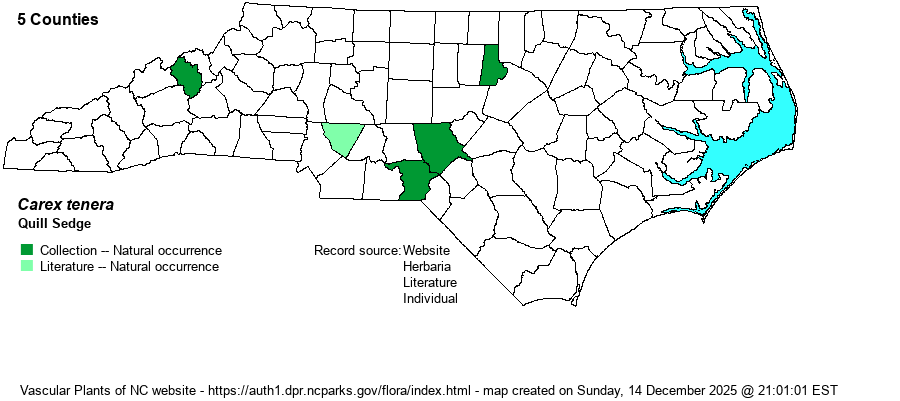| Section 5 » Order Cyperales » Family Cyperaceae |
Show/Hide Synonym
| taxonName | relationship | relatedTaxonName | relatedTaxonRefText | relComments |
|---|
|
| Carex tenera | = | Carex tenera var. tenera | Fernald (1950) | | | Carex tenera | = | Carex tenera var. tenera | Flora of North America (1993b, 1997, 2000, 2002a, 2002b, 2003a, 2004b, 2005, 2006a, 2006b, 2006c, 2007a, 2009, 2010) | | | Carex tenera | = | Carex tenera var. tenera | | | | Carex tenera | < | Carex tenera | Gleason and Cronquist (1991) | | | Carex tenera | < | Carex tenera | Gleason (1952) | | | Carex tenera | < | Carex tenera | | | | Carex tenera | < | Carex tenera | Radford, Ahles, and Bell (1968) | | | Carex tenera | < | Carex tenera | | | | Source: Weakley's Flora |
|
| Author | Dewey | |
| Distribution | Mostly lower Piedmont; disjunct to Yancey County and reported from Cabarrus County. No doubt more numerous than the few records indicate.
N.S. to B.C., south to NC, northern GA, MO, KS, WY, and OR. Not known to occur in VA, so obviously very scarce in the southeastern portion of the range. | |
| Abundance | Very rare. This species seems to be overlooked in NC, as the current range has very little biological meaning -- for a Northern species. It deserves to be listed as Significantly Rare, though the NCNHP only considers it as Watch List status. | |
| Habitat | Not well documented in NC. Moist to seasonally wet floodplains of small rivers, both blackwater and brownwater. Oddly scarce considering a habitat of wet floodplains/swamps. | |
| Phenology | Flowering and fruiting late April-June. | |
| Identification | Quill Sedge is a member of the section Ovales, and needs great care to identify. Apparently it has few well-defined characters. In the field the dark brown spikes are separated from each other (the terminal two may touch) and the inflorescence usually arches. Some but not all perigynia beaks may spread outward. Perigynia are less than 2 mm wide and are narrowly ovate in outline. | |
| Taxonomic Comments | None
The genus Carex is the largest in North America, and among the largest in the world. In temperate and boreal regions, Carex is often the dominant or co-dominant ground layer in many habitats. Seeds (achenes) are valuable food for birds and small mammals, while foliage is used by birds and mammals to make nests and as food by mammals. Species of Carex often look vastly different from one another -- spikes erect vs. drooping, tiny inflorescence vs. whopping, culms leafy vs. naked, perigynia beaked vs. beakless, stems densely bunched vs. single, etc. The genus has been divided into many sections (or groups), based on shared characters; some taxonomists have suggested that these be different genera, but that proves unworkable (so far). All Carex share the feature of a perigynium (an outer covering) which completely surrounds the achene (seed). This covering may fit tightly or loosely (like a small bladder), depending on which group or species. Details of perigynia shape, ornamentation, presence and size of beak, number of striations (or veins) are all important ID features. In recent years Rob Naczi and colleagues have stressed the importance of arrangement of perigynia -- whether spiral (3+ ranks) or distichous (2-ranked) -- and have named a number of new species as well as split off some older synonyms. Therefore, RAB's (1968) key, excellent for its time, can only be used in a general way today. Members of some sections of Carex are difficult to key out (notably Ovales, Laxiflorae, Griseae); this is in part due to variation among individuals of a species, or failings of the key. FNA has drawings of most species and some species may be found in two or more places within a key, to acount for variability. New species to NC, and new to science(!), continue to be found in NC. | |
| Other Common Name(s) | Remote Sedge | |
| State Rank | S1? | |
| Global Rank | G5 | |
| State Status | W7 | |
| US Status | | |
| USACE-agcp | | |
| USACE-emp | | |

